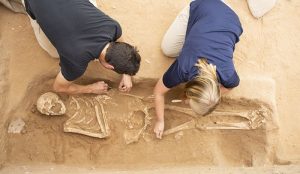Nestes dias os filisteus estão novamente nas manchetes.
Sobre o colapso das grandes civilizações do Antigo Oriente Médio no final da Idade do Bronze e sobre o papel dos “povos do mar” nesta crise – época e contexto em que os filisteus começam a ser citados – há incontáveis bons estudos.
Entretanto, um alerta: graças às descobertas arqueológicas sobre os filisteus feitas nos últimos anos, muitos dos argumentos arqueológicos em obras com mais de uma década estão ultrapassados.
Diz Carl S. Ehrlich, no artigo Philistines, em Oxford Bibliographies, com data de 28 de agosto de 2018:
 Os filisteus eram um povo com raízes no mundo Egeu ou na Anatólia. Eles se estabeleceram no sul da faixa costeira de Canaã por volta do ano 1200 a.C., durante o período de transição entre a Idade do Bronze Recente e a Idade do Ferro.
Os filisteus eram um povo com raízes no mundo Egeu ou na Anatólia. Eles se estabeleceram no sul da faixa costeira de Canaã por volta do ano 1200 a.C., durante o período de transição entre a Idade do Bronze Recente e a Idade do Ferro.
Nas fontes egípcias que datam desta época, eles são um dos chamados “povos do mar” que entraram em conflito com o Egito.
Embora sejam mencionados anacronicamente na Bíblia hebraica tanto nas narrativas patriarcais quanto nas tradições do êxodo, é apenas nas narrativas que tratam da época dos Juízes – particularmente no ciclo de Sansão, em Jz 13–16 – e com a ascensão da monarquia israelita, correspondendo respectivamente à Idade do Ferro Ib e IIa, que eles desempenham o papel de antagonistas dos israelitas. Particularmente de Sansão e do primeiro rei, Saul.
Apesar da atitude negativa do texto em relação a eles, Davi parece ter passado algum tempo como um vassalo filisteu antes de assumir a realeza israelita após a morte de Saul e de seus filhos nas mãos dos filisteus.
Depois da suposta neutralização da ameaça filisteia por Davi, os filisteus aparecem apenas esporadicamente nos textos bíblicos, principalmente nos oráculos proféticos contra as nações.
Segundo os textos bíblicos, os filisteus eram organizados em uma confederação de cinco cidades, a pentápole filisteia: Ashdod, Ascalon e Gaza na costa mediterrânea, e Ekron e Gat mais para o interior. Do ponto de vista dos textos bíblicos, os filisteus eram o “outro” por excelência, distintos dos outros habitantes da Palestina por não serem circuncidados.
Nossa compreensão da história e da cultura filisteias foi grandemente ampliada: primeiro por uma série de textos do Antigo Oriente Médio, particularmente do período do Reino Novo no Egito (séculos XIII-XII a.C.) e do período neoassírio (séculos VIII a VII a.C.); e, segundo, pelos resultados de escavações arqueológicas em sítios filisteus.
Embora um estilo específico de cerâmica bicromática fosse associado aos filisteus já no final do século XIX, foi somente na década de sessenta do século XX que começaram a ser realizadas intensas escavações em cidades da pentápole filisteia – com exceção de Gaza, que está sob a cidade moderna do mesmo nome – e em locais menores e mais periféricos. Isso nos permitiu traçar um quadro muito mais consistente da história, da sociedade e da cultura material dos filisteus.
The Philistines were a people with roots in the Aegean or Anatolian world who settled on the southern coastal strip of Canaan around the year 1200, during the transitional period between the Late Bronze Age and the Early Iron Age. In Egyptian sources dating to this time, they are one among a number of so-called Sea Peoples who came into conflict with Egypt. Although they are mentioned anachronistically in the Hebrew Bible in both the ancestral (i.e., patriarchal) narratives and the exodus traditions, it is only in narratives dealing with the period of the judges (particularly in the Samson cycle: Judges 13–16) and with the rise of the Israelite monarchy, corresponding respectively to Iron Age Ib and IIa, that they play a more central role as antagonists: particularly of Samson and of the first Israelite king, Saul. In spite of the text’s negative attitude toward them, David appears to have spent some time as a Philistine vassal before assuming the mantle of Israelite kingship following the deaths of Saul and most of his sons at Philistine hands. After David’s supposed neutralization of the Philistine threat, the Philistines appear only sporadically in the biblical text, most noticeably in prophetic oracles against the nations. According to biblical literature, the Philistines were organized in a loose confederation of five city-states (the Philistine Pentapolis): Ashdod, Ashkelon, and Gaza along the coast, and Ekron and Gath farther inland, although the latter city does not appear in later texts. From the perspective of the biblical text, the Philistines were the quintessential “other,” distinguished from the other inhabitants of the Levant through their uncircumcised state. Our picture of Philistine history and culture is greatly expanded first by a number of ancient Near Eastern texts, particularly from the late New Kingdom Period in Egypt (13th–12th centuries BCE) and from the neo-Assyrian period (8th–7th centuries BCE), and second by the results of archaeological excavations at Philistine sites. Although a distinctive style of bichrome pottery was associated with the Philistines already at the end of the 19th century, it was not until the 1960s that intensive excavations began to be carried out both at cities of the Philistine Pentapolis (with the exception of Gaza, which is covered by the modern city of the same name) and at smaller and more peripheral sites. These have allowed us to draw a much more nuanced picture of Philistine history, society, and material culture, which oftentimes provides a corrective to the witness of the biblical text.
Para saber mais sobre os filisteus e os “povos do mar”, recomendo o livro de CLINE, E. H. 1177 B.C.: The Year Civilization Collapsed. Princeton: Princeton University Press, 2014, 264 p. – ISBN 978691168388. Vou apresentá-lo no post seguinte. E há uma bibliografia, que cita também recursos online, aqui.
